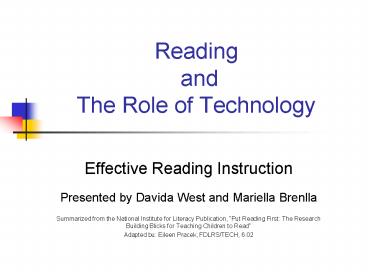Reading and The Role of Technology - PowerPoint PPT Presentation
1 / 29
Title:
Reading and The Role of Technology
Description:
Presented by Davida West and Mariella Brenlla ... the air in all directions, until the campfire took on the semblance of a volcano. ... – PowerPoint PPT presentation
Number of Views:71
Avg rating:3.0/5.0
Title: Reading and The Role of Technology
1
Reading and The Role of Technology
- Effective Reading Instruction
- Presented by Davida West and Mariella Brenlla
- Summarized from the National Institute for
Literacy Publication, Put Reading First The
Research Building Blicks for Teaching Children to
Read - Adapted bu Eileen Pracek, FDLRS/TECH, 6.02
2
The Five Keys of Reading
- Phonemic Awareness
- Phonics
- Vocabulary
- Reading Comprehension
- Fluency
3
Phonemic Awareness
- Hear, identify, and manipulate sounds of spoken
words. - Knowing that words are made up of sounds
4
Phoneme
Phonemic Awareness
5
Phoneme Isolation
- Requires recognizing individual sounds in words
- For example
- Tell me the first sound in paste.
- /p/
Phonemic Awareness
6
Phoneme Identity
- Requires recognizing the common sound in
different words - For example
- Tell me the sound that is the same in bike, boy,
and bell. - /b/
Phonemic Awareness
7
Phoneme Categorization
- Requires recognizing the word with the odd sound
in a sequence of three or four words - For example
- Which word does not belong?
- Bus, bun, rug
- rug
Phonemic Awareness
8
Phoneme Blending
- Requires listening to a sequence of separately
spoken sounds and combining them to form a
recognizable word. - For example
- What word is /s/ /k/ /u/ /l/?
- school
Phonemic Awareness
9
Phoneme Segmentation
- Requires breaking a word into its sounds by
tapping out or counting the sounds or by
pronouncing and positioning a marker for each
sound. - For example
- Tell me all the sounds in the word mop.
- /m/ /o/ /p/
Phonemic Awareness
10
Phonics
- Know relationship between letters of written
language and sounds of spoken language. - The links between sounds and letters.
11
Identify useful series of sounds
Which of these letters combine to create a word?
L G E X
Identify the sounds that make the word.
Phonics
12
Teach them in a logical sequence
Have the child order them using both vision and
auditory skills.
L G E X
LEG
GEL
Phonics
13
Apply sounds to reading and writing
Blend letters into reading and writing. Will the
child be able to recognize the word in a passage?
And then he awoke to find the howling real. There
was a great snarling and yelping. The wolves were
rushing him. They were all about him and upon
him. The teeth of one had closed upon his arm.
Instinctively he leaped into the fire, and as he
leaped, he felt the sharp slash of teeth that
tore through the flesh of his leg. Then began a
fire fight. His stout mittens temporarily
protected his hands, and he scooped live coals
into the air in all directions, until the
campfire took on the semblance of a volcano.
White Fang by Jack London
Phonics
14
Vocabulary
- Words used to communicate effectively or
use/recognize in print - What words mean and how to say them.
15
What is vocabulary really?
- Vocabulary refers to the words we must know to
communicate effectively. - Oral vocabulary - words we use in speaking or
recognize in listening. - Reading vocabulary - words we recognize or use in
print.
16
Indirect Instruction
Students engage in oral language, listen to
adults read to them, and read extensively on
their own.
Teach use of dictionaries, glossaries, thesauruses
, how to use word parts, and context clues.
Teach individual words and word learning
strategies.
Direct Instruction
17
Fluency
- Read text accurately,
- quickly,
- at an appropriate pace.
18
Bridge Between Word Recognition and Comprehension
- Increase practice through audiotapes, peer
guidance, tutors, use of technology
19
Provide models of fluent reading
- Rhythm
- Pace
- Intonation
- Feeling
- Volume
Fluency
20
Provide repeated and monitored oral reading
Scheduled times places ways
Fluency
21
Provide short passages at students independent
level
Three levels Frustration Instructional Indepen
dent
Fluency
22
Comprehension
- The ability to understand what you have read.
23
Comprehension
Comprehension
24
The Big Five
- Reading and the Individual Educational Plan (IEP)
25
(No Transcript)
26
- Quick Facts About Reading
- Reading is complex because language itself is
complicated. - But the special skills of reading, alone, are
pretty manageable. - Fewer than 250 words appear over and over again.
- Just twenty-six letters and perhaps 50 major
'written sounds' make the code. - Reading requires a dose of visual skill and a
large helping of language. - Children need an adequate language foundation to
begin the job of learning to read. - Readers use language skill to 'sound out a word.'
- Written language is a somewhat different
language. - Teachers are more important than methods for
reading success. - http//www.aability.com/rindex.html
27
Sample Sites
- http//www.tampareads.com/ - Web site with
worksheets - http//www.learningfirst.org/ - The Learning
First Alliance represents an unprecedented,
self-initiated commitment by its members to work
in concert to improve student learning.
28
(No Transcript)
29
The End































